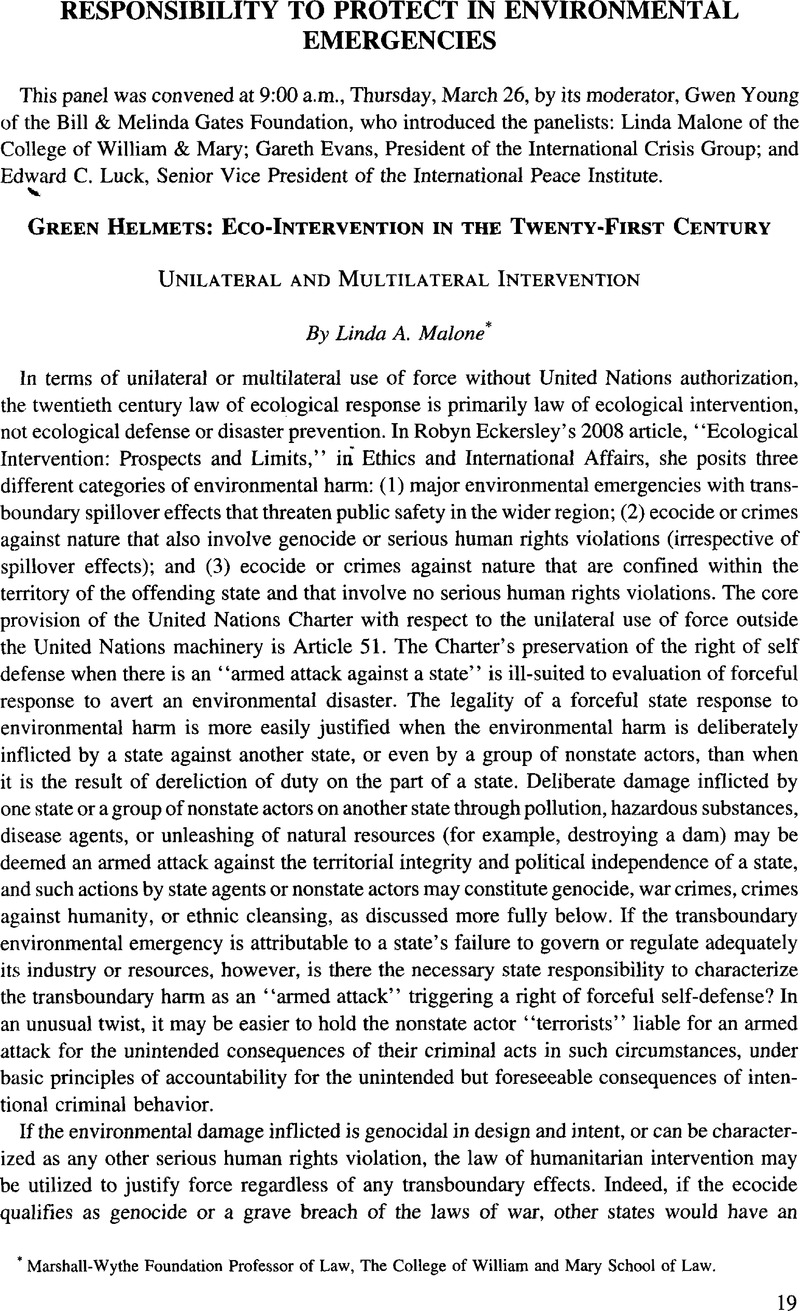Article contents
Green Helmets: Eco-Intervention in the Twenty-First Century
Published online by Cambridge University Press: 28 February 2017
Abstract

- Type
- Responsibility to Protect in Environmental Emergencies
- Information
- Copyright
- Copyright © American Society of International Law 2009
References
1 G.A. Res. A/RES/60/1, ¶ 138 (Oct. 24, 2005); S.C. Res. 1674, ¶ 4, (Apr. 28, 2006) (in which the Security Council reaffirmed provisions of paragraphs 138 and 139 of 2005 World Summit Outcome Document regarding the responsibility to protect).
2 See G.A. Res. A/RES/60/1, ¶ 138 (Oct. 24, 2005).
3 The Responsibility to Protect, Report of the International Commission on Intervention and State Sovereignty VII (2001), available at <http://www.iciss.ca/pdf/Commission-Report.pdf>.
4 Id. at XI.
5 ld.
6 Id. at XII.
7 Id.
8 ld. at XIII.
9 Id. at 54-55.
10 G.A. Res. A/RES/60/1, ¶ 139 (Oct. 24, 2005).
11 Scheffer, D., Atrocity Crimes Framing the Responsibility to Protect, 40 Case W. Res. J. Int’l L. Ill, 115 (2007-08)Google Scholar.
12 Id. at 118-19; see also Scheffer, D., Atrocity Crimes Framing the Responsibility to Protect, in Cooper, R. & Kohler, J., Responsibility to Protect: The Global Moral Compact for the 21st Century 77 (2009) CrossRefGoogle Scholar, which states that:
1. The crime must be of significant magnitude, meaning that its commission is widespread or systematic or occurs as part of a large-scale commission of such crimes. The crime must involve a relatively large number of victims (e.g., a fairly significant number of deaths or wounded casualties), or impose other very severe injury upon noncombatant populations (e.g., massive destruction of private or cultural property), or subject a large number of combatants or prisoners of war to violations of the laws and customs of war. in short, the crime must meet the substantiality test developed by the international and hybrid criminal tribunals.
2. The crime may occur in time of war, or in time of peace, or in time of violent societal upheaval of some organized character, and may be either international or non-international in character.
3. The crime must be identifiable in conventional international criminal law as the crime of genocide, a violation of the laws and customs of war (war crimes), a crime against humanity (the precise definition of which has evolved in the development of the international and hybrid criminal tribunals), or the emerging crime of ethnic cleansing. For purposes of R2P, additional crimes that may become identified in the future as atrocity crimes would be the crime of aggression (if and when it is defined so as to give rise to international individual criminal culpability and is an assault on a civilian population, particularly as an operational crime before the International Criminal Court) and the crime of international terrorism (when it reaches a magnitude comparable to a crime against humanity).
4. The crime must have been led, in its execution, by a ruling or otherwise powerful elite in society (including rebel, insurgent, or terrorist leaders) who planned the commission of the crime or were the leading perpetrators of the crime.
5. The law applicable to such crime, while it may impose state responsibility and even remedies against states, is also regarded under customary international law as holding individuals criminally liable for the commission of such crime, thus enabling the prosecution of such individuals before a court duly constituted for such purpose.
13 The Secretary-General, Report of the Secretary-General on Implementing the Responsibility to Protect, 110(b), delivered to the General Assembly, U.N. Doc. A/63/677 (Jan. 12, 2009).
- 1
- Cited by




